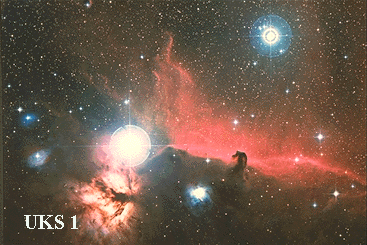
|
Credit & Copyright: Anglo-Australian Telescope
Board
Explanation:
The black indentation to the red
emission nebula
seen just to the right of
center of the above photograph is one of the most famous features in any
nebulae on the sky. Because of its shape, it is known as the
Horsehead
Nebula. The bright star near the center is
located in the belt of the familiar constellation of Orion.
The horse head feature is dark because it is really a dense
dust cloud which lies
in front of the bright nebula and blocks the light.
Like clouds in our sky, this cosmic cloud has chanced to assume
a recognizable shape. After thousands of years, the
internal motions of the cloud will alter its appearance.
The emission nebula's
red color is caused by electrons recombining with protons to form
hydrogen atoms.
Also visible in the picture are blue
reflection nebulae.
This type of nebula contains dust which
preferentially reflects the blue light of nearby stars.
|
January February March April May June July August September October November December |
| ||||||||||||||||||||||||||||||||||||||||||||||||
NASA Web Site Statements, Warnings, and Disclaimers
NASA Official: Jay Norris. Specific rights apply.
A service of: LHEA at NASA / GSFC
& Michigan Tech. U.
Based on Astronomy Picture
Of the Day
Publications with keywords: Orion - Horsehead Nebula
Publications with words: Orion - Horsehead Nebula
See also:
- A December Winter Night
- APOD: 2024 November 25 Á The Horsehead Nebula
- APOD: 2024 September 10 Á Horsehead and Orion Nebulas
- APOD: 2024 January 31 Á Camera Orion Rising
- APOD: 2024 January 16 Á The Orion You Can Almost See
- APOD: 2023 November 20 Á The Horsehead Nebula
- APOD: 2023 January 25 Á LDN 1622: The Boogeyman Nebula
